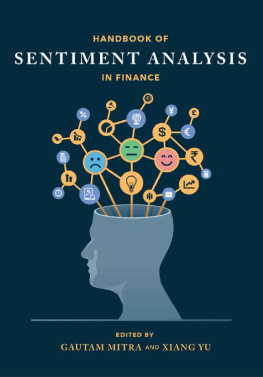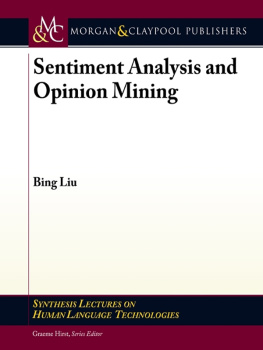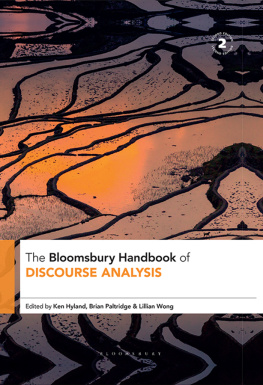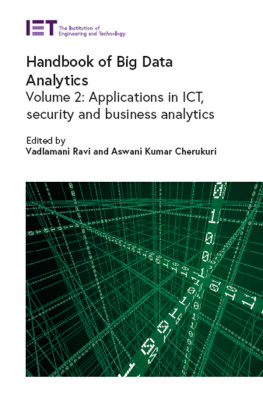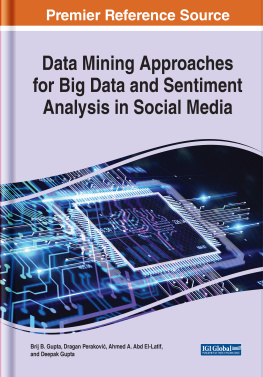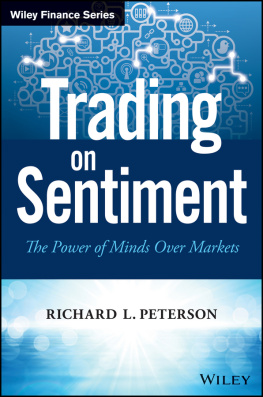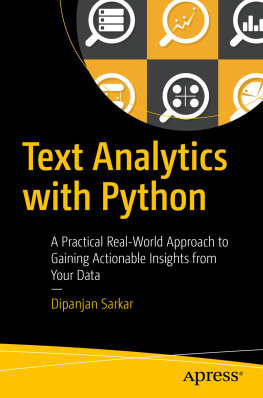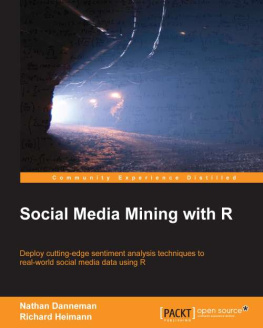HANDBOOK OF
SENTIMENT ANALYSIS
IN FINANCE
EDITED BY
GAUTAM MITRA
AND
XIANG YU
ENDORSEMENTS
The technology of extracting financial sentiment from news feeds and other such sources continues to advance. This volume, an update of the earlier Handbook of News Analytics in Finance , describes the current state of the art, illustrating the considerable progress over the past five years. It will provide an indispensible introduction to the area, as well as a comprehensive reference work.
Professor David J. Hand
Emeritus Professor of Mathematics, Imperial College, London Chief Scientific Advisor, Winton Capital Management
An excellent collection of studies into how market prices respond to the flow of information in the economy. Many sources of information ranging from prominent news stories through to social media discussions are analyzed for their impact on asset pricing, including the development of strategies trading the flow of information. The handbook is a fundamental addition to understanding the origins, processes and pathways of price discovery.
Prof Dilip Madan
Professor of Finance, Robert H. Smith School of Business
Mitra and Yu have done a comprehensive coverage of the sentiment analysis in finance. The handbook is both timely and relevant to the current state of research on news analytics, social media analytics and the impact on financial markets. Finance researchers interested in information transmission, news sentiment and investors trading behavior, ranging from a high-frequency to a longer-horizon, have a lot to gain from reading this book. This book has the potential to shape the next generation of sentiment analysis in finance.
Andreas Milidonis, Ph.D.,
Assistant Professor in Finance, University of Cyprus.
This book contains amazing insights into the analysis of sentiment. The sentiment that expresses people's emotions reflects what sources they use to obtain new information, what they say, what they write, how they behave as part of crowds including networks, and what decisions they make as individuals. Sentiment is complex and multidimensional, and this book offers systematic, novel approaches for addressing that multidimensional complexity. Readers will find fascinating practical applications to the analysis of news about non-farm payroll, corporate earnings, stock returns, commodities, options, and corporate debt.
Prof Hersh Shefrin
Mario L. Belotti Professor of Finance, Santa Clara University
The effective quantification of non-standard, non-numerical data has opened up vast new avenues of investment signal research. This volume provides a cogent and valuable summary of the current research in this area.
Peter Swank, Ph.D.,
Vice President, Tudor Investment Corporation
TABLE OF CONTENTS
Gautam Mitra and Xiang Yu
Stephen Pulman
Bing Liu
Bing Liu
Olga Kolchyna, Tharsis Souza, Philip Treleaven and Tomaso Aste
Federico Pozzi, Enza Messina and Elisabetta Fersini
Helen Susannah Moat, Chester Curme, Adam Avakian, Dror Y. Kenett, H. Eugene Stanley and Tobias Preis
Asher Curtis, Vernon J. Richardson and Roy Schmardebeck
Gurvinder Brar, Giuliano De Rossi and Nilesh Kalamkar
Elijah DePalma
Peter Hafez
Richard Peterson
Xiang Yu, Gautam Mitra, Cristiano Arbex-Valle and Tilman Sayer
Eric Tham
Svetlana Borovkova
Richard Peterson and Aleksander Fafula
Dan diBartolomeo
Saeed Amen
Richard Peterson and Changjie Liu
Nitish Sinha and Wei Dong
Michal Dzielinski
Gautam Mitra, Xiang Yu, Dan diBartolomeo and Ashok Banerjee
Tharsis Souza, Olga Kolchyna and Tomaso Aste
Abby Levenberg, Edwin Simpson, Stephen Roberts, Stephen Pulman , Karo Moilanen, Georg Gottlob
BACKGROUND
As the saying goes every book tells a story; this is true even when it is a scientific tome. Our journey started with The Handbook of News Analytics in Finance (2011); but we have stayed the course and continued to research this topic, networked with the industry leaders and leading academics who have contributed to this field. For this Handbook research started when my academic colleague Dr Keming Yu suggested to his daughter, Xiang Yu, to join us for PhD research in the summer of 2010. Xiang enthusiastically embraced the research topic, diligently worked at Brunel University and OptiRisk as an industry sponsored PhD researcher holding an EPSRC bursary. So it is with thanks to both Keming and EPSRC that this research has been possible. Since Xiangs research was focused on the topic Analysis of news sentiment and its application to Finance it gave us a head start in compiling some of the contents at an early stage of our preparation. Throughout these years, OptiRisk have organised annual conferences dedicated to this topic, further focusing our minds to other facets of research and in the domain of sentiment analysis applied to finance. As a result of this continuous exposure to the problems as well as the technologies and the progress achieved in this domain we have ventured to compile this Handbook and share this knowledge with the practitioners as well as researchers in this field.
WHATS NEW?
A tremendous amount of progress has been made in the last 5 years, since we compiled and published our last handbook: The Handbook of News Analytics in Finance . We set out below in a summary form some of the salient aspects:
The technology of natural language processing (NLP) has been added to earlier approaches to text mining and sentiment classification. has brought improvements to accuracy.
Many alternative information sources have emerged in the last few years; in particular there has been an explosion of information that arrive through blogs and the net. This has on one hand triggered innovative research on the other hand presented problems of trust. For instance we are faced with two classes of information:
i. Curated information:
macroeconomic news, company reports and filings
Newswires with editorial oversight
ii. Un-curated information:
Microblogs (Twitter)
On-line search information, Google and Wikipedia
The research in this domain started with equities. But today a number of other asset classes are also covered by sentiment meta-data. These include: commodities, fixed income and FX.
THE ROAD MAP
As editors we had to make two important decisions, namely, the contributions we solicited and the structure within which we presented these contributions as chapters. We have as editors gave our perspective of progress in sentiment analysis applied to finance in the form of an overview chapter. In this chapter we set the scene and introduce readers to the recent developments made in sentiment analysis. We have covered the salient aspects, that are, the classification process, sources of information and applications of sentiment meta data to finance. This overview chapter we recommend as a starting point for the newcomers who wish to make a quick entry to this field. The rest of the handbook has been structured as follows:
Part I TEXT ANAYTICS AND SENTIMENT CLASSIFICATION:
In this part we have included three chapters which relate to Compositional Sentiment Analysis, Document Sentiment Classification and how sentence structures are used in Sentiment Classification.

